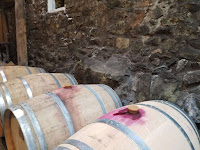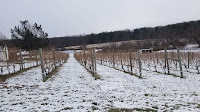
On a trip home from Waynesboro, I decided to ditch the tractor-trailer-laden Route 81 and ventured north on the more peaceful and bucolic Route 340. This allowed me to follow portions of both the
Shenandoah Beerwerks Trail and the
Shenandoah Spirits Trail while passing through the towns of Elkton, Shenandoah, and Luray. In total, I stopped at eight establishments, most for the first time, and returned home with enough beverages to carry me through the rest of the month.
 Basic City Beer Company
Basic City Beer CompanyThe Shenandoah Beerwerks Trail runs from the Harrisonburg area south to Lexington and Rockbridge County. Waynesboro is basically halfway between the two borders and is home to a favorite brewery Basic City Beer Co. and #thecompasscbf stop number 45. The brewery is housed in the former Virginia Metalcrafters building and is a destination itself with pizza and various arcade games (shuffleboard, pinball, etc), plus a large selection of beer. I usually stock up on two staples the Our Daily Pils German Pilsner and whatever Grin's Casket is available. On this visit, it was the Cherry Quad aged in Heaven Hill bourbon barrels with almonds. Can't wait to open during a firepit night.
Elkton Brewing CompanyRemaining on the Shenandoah Beerwerks Trail, we headed north on Rt 340 to Elkton -- a small town situated between Massanutten Mountain and Skyline Drive -- and settled by German and Scots-Irish immigrants similar to the founders of Elkton Brewing (#thecompasscbf stop number 46). The Napotnik family opened the brewery in a building originally built in 1890 to house the Elkton Milling Company. They brew a large array of beers and had 14 on tap on our arrival. Our flight consisted of the Nekid Crik Kolsch, Blonde Bear Blonde Ale, Uncommon Elk California Common, and the BoysenTuley Pie Boysenberry + Graham Cracker + Vanilla GOSE / Sour. I can't imagine the thought process of Colonel Gos Tuley, who was responsible for killing the last known indigenous Virginia Elk in 1855. The Uncommon Elk was the favorite and worked well with the Bayou Gumbo available at the food truck.
Chateau VirginiaAfter leaving Elkton Brewing I noticed a Winery sign a block away and stopped to discover Chateau Virginia - a new Virginia winery that officially just opened in April. The winery is producing wine from Shenandoah grapes that hopefully will be available in the near future. Winemaker and founder Andrew Starkey studied and worked for two years in Champagne specifically at Crezancy. Andrew's sister Amanda is the resident sommelier. She also studied in France and was the sommelier at Pippen Hill Winery and The Inn at Little Washington. The winery also offers a wide selection of wines from around the world starting close to home with Williamsburg Winery but also with a special emphasis on Bordeaux, Beaujolais, Piemonte Italy, and Mendoza.
 Wisteria Farm and Vineyard
Wisteria Farm and VineyardFrom Elkton, we continued North on Rt 340 towards Luray, diverging onto Business 340 and Wisteria Farm and Vineyard. The farm is situated in the Page Valley enclosed by the Massenutten range to the west and Skyline Drive to the east and still within the Shenandoah Valley proper. And is fully part of the Shenandoah Spirits Trail. Not only do they produce wine from their estate grapes, but have a small flock of natural-colored Romney sheep as well as free-roaming chickens. I indulged in a flight consisting of the dry Seyval ($21), Persephone dry rose ($24), Chambourcin ($24), and Ashtaroot Petnat ($23). The Seyval was rather satisfying and I purchased a bottle of the Persephone primarily because of its unique flavor profile where the blend includes some Norton.
River Hill Wine and SpiritsThis was our second visit to River Hill Wine and Spirits, the first precipitated after purchasing a bottle of their Corn Whiskey and Bourbon at an ABC store. This is a very small operation, located just minutes outside of Luray. On this visit, I discovered they just released a Rye Whiskey -- aged 12 months in oak. It's quite different from the spicier versions coming out of Kentucky - grassy and earthy, with a little chalk, dark chocolate, and licorice. Loads of flavors.
 Blue Shepherd Spirits
Blue Shepherd SpiritsWe reached a milestone last weekend, visiting our 50th craft beverage establishment in 2023. This was Blue Shepherd Spirits, a distillery that opened in August 2022, very close to the caverns. Their three main spirits are vodka, gin, and rum with the mash for the first two based on local corn and sugar. The New World Gin has a citrus profile that is complimented by the juniper. The Dog Days of Summer Rum (90 proof) is distilled using both molasses and cane juice and infused with various spices. Not overly spiced however and has a nice balance with the traditional rum flavor. We purchased a bottle to use with our iiCiNG Pina Colada flavoring. Unfortunately, we couldn't purchase a bottle of our favorite spirit, their 6-month-aged Whiskey because of limited production. This is a complex whiskey made from a 70% corn, 20% rye, and 10% malted barley mash. Plenty of vanilla, caramel, honey, and a little rye spice.
 Hawksbill Brewing Co.
Hawksbill Brewing Co.
Our final stop in downtown Luray was Hawksbill Brewing Co., a six-year-old brewery that specifically targets using Page County grown ingredients. This was a bustling brewery with lots of beer drinkers with their dogs enjoying an interesting array of beer. My flight consisted of The Haymaker Cream Ale (a few cans came home with us), Bearfence Black Lager, Farmer's Brown Ale, and the Brown Cow Nitro Stout. Solid beers.
 Castle Vineyards
Castle Vineyards
It was appropriate that we started our trip in Waynesboro -- not far from Fishersville and
Barren Ridge Vineyards -- and ended it at Castle Vineyards, a satellite tasting room for that winery. Actually, it's a joint venture between the descendants of Ralph Castle Davis (thus Castle Vineyards), a local businessman and farmer. R. Steven Davis (Uncle) and Jeremy A. McCoy (nephew) planted Viognier within their working cattle farm and partnered with Barren Ridge to host their wines surrounded by excellent views of the Shenandoah Valley and Blie Ridge Mountains. After a tasting of most of their portfolio, we returned home with our three favorites starting with the delicious 2020 Cabernet Franc. Two white blends also caught our fancy, first, the 2021 Harmony blends Petit Manseng, Viognier, Vidal Blanc, Chardonnay, and Sauvignon Blanc. Imagine the aroma in that bottle. Second was the 2021 Tinkling Spring, a blend of Riesling, Traminette, and Vidal -- more strong aromas and tropical fruit and saline.

















































